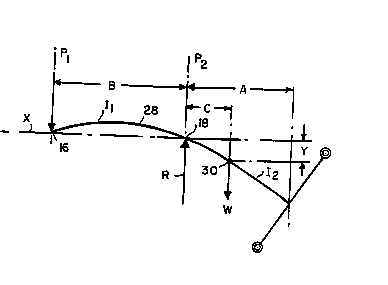Une partie des informations de ce site Web a été fournie par des sources externes. Le gouvernement du Canada n'assume aucune responsabilité concernant la précision, l'actualité ou la fiabilité des informations fournies par les sources externes. Les utilisateurs qui désirent employer cette information devraient consulter directement la source des informations. Le contenu fourni par les sources externes n'est pas assujetti aux exigences sur les langues officielles, la protection des renseignements personnels et l'accessibilité.
L'apparition de différences dans le texte et l'image des Revendications et de l'Abrégé dépend du moment auquel le document est publié. Les textes des Revendications et de l'Abrégé sont affichés :
| (12) Brevet: | (11) CA 2145459 |
|---|---|
| (54) Titre français: | TETE DE LAMINOIR ULTRARAPIDE |
| (54) Titre anglais: | HIGH SPEED LAYING HEAD |
| Statut: | Durée expirée - au-delà du délai suivant l'octroi |
| (51) Classification internationale des brevets (CIB): |
|
|---|---|
| (72) Inventeurs : |
|
| (73) Titulaires : |
|
| (71) Demandeurs : |
|
| (74) Agent: | SMART & BIGGAR LP |
| (74) Co-agent: | |
| (45) Délivré: | 1999-01-12 |
| (22) Date de dépôt: | 1995-03-24 |
| (41) Mise à la disponibilité du public: | 1995-10-27 |
| Requête d'examen: | 1995-03-24 |
| Licence disponible: | S.O. |
| Cédé au domaine public: | S.O. |
| (25) Langue des documents déposés: | Anglais |
| Traité de coopération en matière de brevets (PCT): | Non |
|---|
| (30) Données de priorité de la demande: | ||||||
|---|---|---|---|---|---|---|
|
Tête de laminoir à fourreau supportée, aux fins de rotation, sur son axe longitudinal entre un premier et un deuxième roulements séparés axialement. Un conduit est porté par le fourreau pour en assurer la rotation. Le conduit présente une section d'entrée réalisée sur l'axe du fourreau, entre les premier et deuxième roulements, et une section intermédiaire tridimensionnelle courbée passant dans le deuxième roulement et en ressortant, pour se terminer à une extrémité de sortie espacée radialement de l'axe du fourreau de manière à constituer une voie d'acheminement circulaire. La dimension du conduit sortant du deuxième roulement est inférieure au diamètre de la voie circulaire.
A rolling mill laying head as a quill supported for rotation about its longitudinal axis
between axially spaced first and second bearing assemblies. A laying pipe is carried by the quill
for rotation therewith. The laying pipe has an entry section lying on the quill axis between the
first and second bearing assemblies, and a three dimensionally curved intermediate section
extending through and beyond the second bearing assembly to terminate at a delivery end spaced
radially from the quill axis to define a circular path of travel. The dimension by which the
laying pipe extends beyond the second bearing assembly is less than the diameter of the circular
path.
Note : Les revendications sont présentées dans la langue officielle dans laquelle elles ont été soumises.
Note : Les descriptions sont présentées dans la langue officielle dans laquelle elles ont été soumises.

2024-08-01 : Dans le cadre de la transition vers les Brevets de nouvelle génération (BNG), la base de données sur les brevets canadiens (BDBC) contient désormais un Historique d'événement plus détaillé, qui reproduit le Journal des événements de notre nouvelle solution interne.
Veuillez noter que les événements débutant par « Inactive : » se réfèrent à des événements qui ne sont plus utilisés dans notre nouvelle solution interne.
Pour une meilleure compréhension de l'état de la demande ou brevet qui figure sur cette page, la rubrique Mise en garde , et les descriptions de Brevet , Historique d'événement , Taxes périodiques et Historique des paiements devraient être consultées.
| Description | Date |
|---|---|
| Inactive : Périmé (brevet - nouvelle loi) | 2015-03-24 |
| Lettre envoyée | 2010-12-07 |
| Lettre envoyée | 2010-12-07 |
| Inactive : Lettre officielle | 2010-05-18 |
| Inactive : Lettre officielle | 2010-05-18 |
| Demande visant la révocation de la nomination d'un agent | 2010-03-09 |
| Demande visant la nomination d'un agent | 2010-03-09 |
| Inactive : CIB de MCD | 2006-03-11 |
| Accordé par délivrance | 1999-01-12 |
| Préoctroi | 1998-08-27 |
| Inactive : Taxe finale reçue | 1998-08-27 |
| Un avis d'acceptation est envoyé | 1998-03-10 |
| Lettre envoyée | 1998-03-10 |
| Un avis d'acceptation est envoyé | 1998-03-10 |
| Inactive : Renseign. sur l'état - Complets dès date d'ent. journ. | 1998-03-05 |
| Inactive : Dem. traitée sur TS dès date d'ent. journal | 1998-03-05 |
| Inactive : Approuvée aux fins d'acceptation (AFA) | 1998-02-11 |
| Demande publiée (accessible au public) | 1995-10-27 |
| Exigences pour une requête d'examen - jugée conforme | 1995-03-24 |
| Toutes les exigences pour l'examen - jugée conforme | 1995-03-24 |
Il n'y a pas d'historique d'abandonnement
Le dernier paiement a été reçu le 1998-03-04
Avis : Si le paiement en totalité n'a pas été reçu au plus tard à la date indiquée, une taxe supplémentaire peut être imposée, soit une des taxes suivantes :
Les taxes sur les brevets sont ajustées au 1er janvier de chaque année. Les montants ci-dessus sont les montants actuels s'ils sont reçus au plus tard le 31 décembre de l'année en cours.
Veuillez vous référer à la page web des
taxes sur les brevets
de l'OPIC pour voir tous les montants actuels des taxes.
Les titulaires actuels et antérieures au dossier sont affichés en ordre alphabétique.
| Titulaires actuels au dossier |
|---|
| SIEMENS INDUSTRY, INC. |
| Titulaires antérieures au dossier |
|---|
| HAROLD E. WOODROW |
| TERENCE M. SHORE |